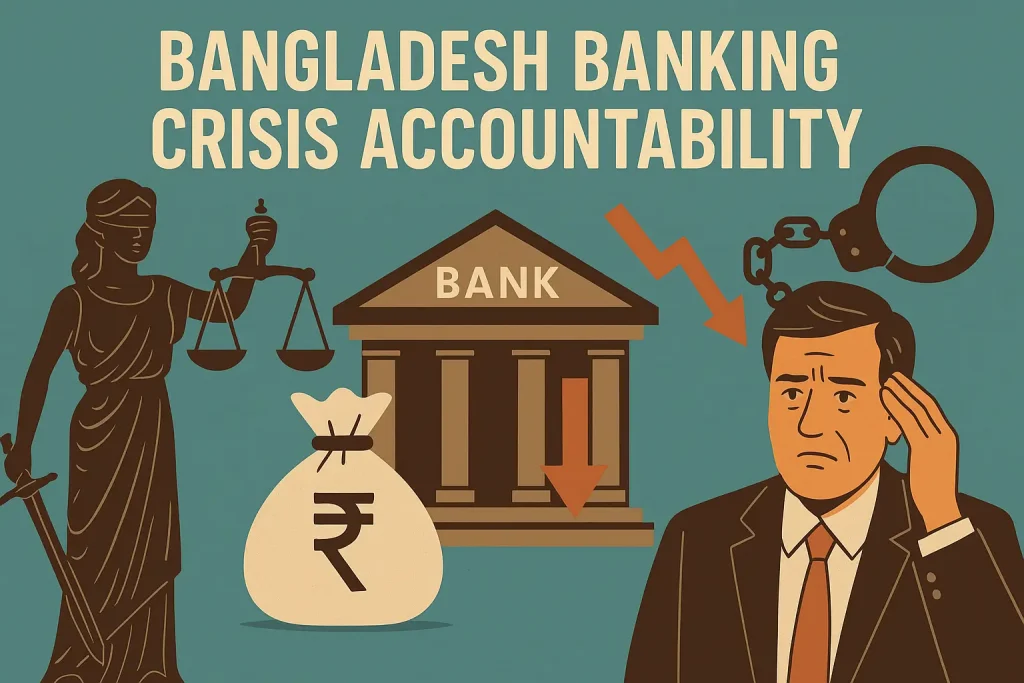As Bangladesh grapples with surging non-performing loans, high-profile prosecutions and frozen overseas assets, a stark question has moved from whispered boardroom talk to the front pages: are the costs of a banking collapse being quietly shifted onto ordinary citizens — or will the state accept responsibility to restore the system and punish those responsible?
Bangladesh Banking Crisis Accountability
The crisis is real and deep. According to the central bank’s 2024 Financial Stability Report, gross non-performing loans (NPLs) across the banking system stood at 20.25%, with state-owned commercial banks (SOCBs) in particularly precarious shape — gross NPLs topping 40% in some cases. Add widely reported allegations of large-value diversion and misappropriation, and the result is a banking sector under severe strain, depositor confidence shaken, and credit to the real economy constrained.
Policy makers and international partners — from the IMF to the World Bank and ADB — have issued a repeated refrain: clean up the banks, hold wrongdoers to account, and do so in a way that protects depositors and the wider economy. But the question of how to do that fairly and effectively has been fiercely contested.
A unified recovery — and where to put it
A policy blueprint gaining traction among legal experts, international advisers and former central-bank officials argues for a single, tightly governed recovery vehicle: an RRO (Recovery & Reform Operation) hosted inside Bangladesh Bank. The RRO would combine three complementary elements:
- An Asset Management Corporation (AMC) embedded in the central bank to buy and manage bad loans, recapitalise cleaned banks and oversee asset disposals;
- A strengthened Bangladesh Financial Intelligence Unit (BFIU) liaison cell to trace cross-border flows, analyse suspicious transaction reports and feed evidence into enforcement; and
- A specialised Finance Tribunal (fast-track court) to attach assets, freeze accounts and prosecute willful defaults quickly and transparently.
Proponents argue the model strikes a balance: the central bank provides the permanent institutional home and macroprudential oversight; the BFIU supplies AML expertise needed for cross-border recovery; and the tribunal delivers speed and enforceability without subverting due process. Crucially, the architecture is designed to avoid “blanket bailouts.” Instead of an open-ended fiscal recapitalisation that would inflate public debt or fuel inflation, the AMC would be capitalised by government-backed, recoverable instruments, and repayments would be financed through asset-recovery proceeds.
A proactive safeguard
Beyond post-crisis recovery, the RRO is proposed to be a proactive guardian of system integrity. Under the design, any large credit proposal — for example loans above BDT 50 crore — would trigger enhanced due diligence and an RRO clearance step before final approval. That function would act as an early-warning and pre-emptive stop-gap: risk indicators would be escalated to the BFIU-liaison cell, forensic checks and cross-border trace requests would be initiated where necessary, and the Finance Tribunal could be asked to place an interim hold while investigations proceed. The intention is to detect and block high-value abuse in the planning stage, not only after losses have crystallised.
Lessons from abroad — and domestic pitfalls
The proposal draws on lessons from past AMCs around the world. Malaysia’s Danaharta and Korea’s KAMCO demonstrate how well-run AMCs can restore bank balance sheets and recover value when paired with strong legal frameworks and transparency. But other cases — notably Indonesia’s IBRA and certain experiences in China — underline the dangers of political interference and moral hazard when asset managers are captured or governance reforms lag.
That history yields two non-negotiables for the RRO design: independence and visibility. The recovery vehicle must have protected governance (independent advisory boards with international experts), regular public reporting, and a whistleblower-safe environment to prevent recapture by the same networks that created the problem.
Will the state shoulder the cost — or push it onto citizens?
The central tension is political and fiscal. Some stakeholders fear that a large, poorly structured state intervention will simply convert private losses into public debt — fuelling inflation and shrinking spending on health, education, and social safety nets. Others warn that doing too little risks a prolonged credit squeeze that crushes growth and employment — costs borne disproportionately by the poor.
The RRO model attempts a middle path: state-backed but recovery-focused, with strict prioritisation of depositors and an explicit waterfall that channels recovery proceeds first to servicing AMC obligations and then to recapitalisation priorities. In practice, success depends on two factors: realistic valuations and disciplined asset sales, and rigorous prosecution of directors and owners found complicit in fraud or willful default.
What comes next
- Statutory basis: a compact RRO Act that grants Bangladesh Bank the AMC mandate and empowers the Tribunal to act swiftly;
- Pilot phase: an initial, limited transfer of clearly identified portfolios to prove valuation and recovery mechanisms;
- International partnership: donor support for seed capital, technical assistance and independent audits;
- Transparency safeguards: quarterly public scorecards and independent oversight to build credibility;
- Operational safeguards: implement the proposed enhanced due-diligence gate for large loans (e.g., >BDT 50 crore) so potential abuses are flagged and investigated before funds are disbursed.
If implemented well, the proposal could stabilise the banking system without turning private failure into a blanket public bailout. If it is delayed or hollowed out, ordinary citizens risk paying in the form of higher prices, slower growth, or eroded social spending.
Why it matters
This is not a dry accounting exercise; it is a test of whether the state will enforce the rules it sets. When a crisis is effectively enabled or tolerated because powerful, politically connected actors flouted financial laws, letting the cost fall quietly on ordinary people is both unjust and profoundly dangerous.
Punishing those who broke the rules — through asset recovery, criminal prosecution, director disqualification and civil redress — does more than reclaim money: it reaffirms the rule that no one is above the law. Visible, credible accountability creates a strong deterrent. Future borrowers, bankers and owners will think twice before engineering risky or fraudulent schemes if they see real consequences, not symbolic statements.
If, instead, losses are socialised — absorbed by taxpayers, masked as broad bailouts, or hidden in austerity that cuts public services — the moral hazard is stark. The perverse message becomes: misconduct is affordable. That encourages repetition: the same networks, or others watching, will treat the system as a source of private gain rather than a public trust. Over time institutional credibility erodes, honest investment is discouraged, and inequality deepens because ordinary savers and wage-earners shoulder the fallout while the powerful escape unpunished.
A credible recovery operation must therefore combine repair with retribution: clean up balance sheets and protect depositors, yes — but do so while publicly holding culpable managers and owners to account. That mix restores trust in markets and in the state itself. It teaches citizens that rules matter, that illicit gain will be exposed, and that public institutions can and will act to defend the common good. In short, accountability is not merely punitive: it is preventive, restorative, and essential to rebuilding a culture of financial responsibility across society.
Why it matters to ordinary people
When the rule of law is upheld and justice is seen to work, ordinary people gain confidence — to save, to borrow, to invest. When the law fails, the opposite happens: distrust grows, capital flees, credit tightens, and everyday livelihoods suffer. Restoring accountability in finance is therefore a social compact as much as a technical fix.
Box — What is the proposed RRO?
A permanent recovery arm inside Bangladesh Bank that: hosts an AMC to buy bad loans; works with the BFIU to trace illicit flows; uses a fast-track Finance Tribunal to attach assets and prosecute. Priority: protect depositors and use recovered assets to repay AMC obligations rather than taxing citizens. The unit will also act proactively — applying enhanced due-diligence to large credit proposals (e.g., loans above BDT 50 crore) to detect and block suspected abuse before losses occur.
Written By: Md. Rawnak Hossain




